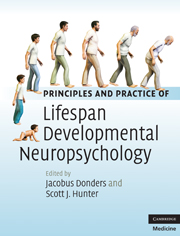Book contents
- Frontmatter
- Contents
- Contact information for authors
- Biography for Jacobus Donders and Scott J. Hunter
- Introduction
- Section I Theory and models
- 1 A lifespan review of developmental neuroanatomy
- 2a Developmental models in pediatric neuropsychology
- 2b Models of developmental neuropsychology: adult and geriatric
- 3 Multicultural considerations in lifespan neuropsychological assessment
- 4 Structural and functional neuroimaging throughout the lifespan
- Section II Disorders
- Index
- Plate section
- References
1 - A lifespan review of developmental neuroanatomy
from Section I - Theory and models
Published online by Cambridge University Press: 07 May 2010
- Frontmatter
- Contents
- Contact information for authors
- Biography for Jacobus Donders and Scott J. Hunter
- Introduction
- Section I Theory and models
- 1 A lifespan review of developmental neuroanatomy
- 2a Developmental models in pediatric neuropsychology
- 2b Models of developmental neuropsychology: adult and geriatric
- 3 Multicultural considerations in lifespan neuropsychological assessment
- 4 Structural and functional neuroimaging throughout the lifespan
- Section II Disorders
- Index
- Plate section
- References
Summary
On the development of functional neural systems
The structure of the brain is in constant flux from the moment of its conception to the firing of its final nerve impulse in death. As the brain develops, functional networks are created that underlie our cognitive and emotional capacities. Our technologies for evaluating these functional systems have changed over time as well, evolving from lesion-based case studies, neuropathological analyses, in vivo neurophysiological techniques (e.g. electroencephalography), and in vivo structural evaluation (CT scan, magnetic resonance imaging (MRI), diffusion tensor imaging (DTI)), to in vivo functional methodologies (functional magnetic resonance imaging (fMRI), positron emission tomography (PET)). And with these rapidly developing technologies, we are able to more thoroughly test some of the earlier hypotheses that were developed about the nature and function of the brain.
Although attempts to localize mental processes to the brain may be traced to antiquity, the phrenologists Gall and Spurtzheim may have initiated the first modern attempt, by hypothesizing that language is confined to the frontal lobes [1]. While these early hypotheses were largely ignored as phrenology fell in ill-repute, they were resurrected in the early 1860s by Paul Broca, who, inspired by a discussion of the phrenologists' work, sparked a renewed interest in localization of brain function with his seminal case studies on aphasia [2]. Broca's explorations were among the earliest examples of lateralized language dominance.
Information
- Type
- Chapter
- Information
- Publisher: Cambridge University PressPrint publication year: 2010
References
Accessibility standard: Unknown
Why this information is here
This section outlines the accessibility features of this content - including support for screen readers, full keyboard navigation and high-contrast display options. This may not be relevant for you.Accessibility Information
- 2
- Cited by
